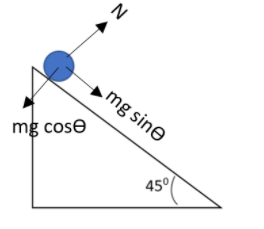Question
Question: A disc has a radius \(20cm\) and a mass half kg found to be rolling on an inclined plane. What will ...
A disc has a radius 20cm and a mass half kg found to be rolling on an inclined plane. What will be the force of friction so that the disc will perform pure rolling?

A.352NB.325NC.25ND.235N
Solution
From the diagram, derive the equation of the balancing of the force. The torque of the centre of mass can be found to be equivalent to the product of the moment of inertia of the centre of mass and the angular acceleration of the body. Rearrange the equation in terms of friction. Substitute the torque in this and substitute the values. This will help you in answering this question.
Complete step by step answer:

It has been mentioned that the radius of the disk has been given as,
r=20cm
Mass of the body has been mentioned as,
m=21Kg
According to the diagram mentioned, we can write that,
mgsinθ−f=macm…….. (1)
Where fbe the force of friction.
The torque of the centre of mass can be found to be equivalent to the product of the moment of inertia of the centre of mass and the angular acceleration of the body. That is we can write that,
τcm=Icm⋅α
And also we can write that,
fR=2MR2×(R2acm)
Simplifying this equation can be written as,
fR=2M×acm
Rearranging this equation can be written as,
acm=M2f
Substituting this in equation (1) can be shown as,
mgsinθ−f=M(M2f)
From this the force of friction can be found to be as,
f=3mgsinθ
The angle of inclination has been mentioned as,
θ=45∘
Substituting all these values in it will give,
f=2×3×21×10×1=325N
Hence the force of friction has been found to be,
f=325N
So, the correct answer is “Option B”.
Note: Centre of mass is the imaginary point of a body or a particle which is considered to be the point where the whole mass of the body is found to be concentrated. All the properties of the body will be shown by this particle. Frictional force is the opposition provided due to the surface body interactions.
